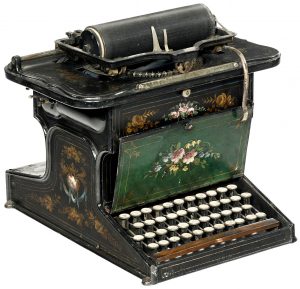
Smart phones, iPads, and laptops are recent innovations, but their human interface is a Victorian technology that is almost 150 years-old. The QWERTY keyboard appeared first in an 1868 typewriter patent granted to Christopher Sholes, Carlos Glidden and Samuel Soule. The patent was acquired by E. Remington and Sons, a firearms and sewing machine manufacturer, and 5 years later, the so-called Sholes & Glidden, also known as the Remington 1, appeared. The machine was not perfect—it typed exclusively in caps, and the typist worked “blind,” that is, she could not see what she was typing since the keys struck the underside of the platen). Nevertheless it was a commercial success—Mark Twain was an early adopter and Life on the Mississippi became the first typewritten manuscript ever summited to a publisher.
Later typewriters added a shift lever that allowed upper and lower case typing, and solved the typing blind problem, but the QWERTY keyboard, said to be invented by Sholes, a Wisconsin newspaperman, remained (and remains today, slightly modified to meet the needs of different languages—QWERTZ in Polish). According to Martin Howard, whose collection of antique typewriters can be viewed on his website, the odd arrangement separated letters that were frequently typed together to avoid clashing of type bars. Thanks to the Remington 2, called the Model T of typewriters, the QWERTY keyboard, enjoying the first-mover advantage, became the de facto standard and resisted all efforts to replace it with alternative arrangements. Like the musical keyboard, which dates back to at least the fourteenth century, the QWERTY keyboard seems destined to endure.
